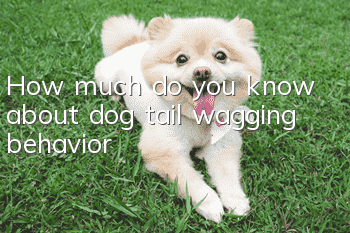How much do you know about dog tail wagging behavior?

Whether it is laypeople or experts, it is often said that as long as a dog wags its tail, it means it is friendly, but this is not true. This mistake is the same as insisting that a cat wagging its tail means it is angry. Whether it's a dog or a cat, tail wagging only expresses one emotion, which is a state of psychological ambivalence. In animal communication, all tail wagging back and forth pretty much means this.
When an animal is in a conflicting state, it will feel the pull in two different directions at the same time: it wants to move forward but wants to go back at the same time; or it wants to turn left and want to turn right at the same time. Since the two ideas are in conflict with each other, the animal remains where it is, but is mentally stressed. Its body (or body part) will obey one of the desires and start moving in a certain direction, but then stop and move in the opposite direction. This phenomenon triggers a series of specific forms of visual signals in the body language of different species, such as neck twisting, head bobbing, tail flicking, and the well-known tail wagging.
When a dog is wagging its tail, what is its mental state? Basically, it wants to stay and go away. The reason for wanting to leave is simple: fear. But the desire to stay is more complicated. In fact, there is not just one reason for wanting to stay, but several. It may be because it wants to stay because it is hungry, to show friendship, to be hostile, or for other reasons. This is why the wagging tail cannot be labeled as a single label. The visual signal of tail wagging must be combined with the actions occurring at the same time and interpreted in real-life situations. The following examples will help clarify this issue:
Puppies do not wag their tails when they are very young. The earliest documented observation of tail wagging was in a 17-day-old puppy, but this is rare. By 30 days of age, about 50% of puppies are wagging their tails, and this movement is fully mature by 49 days of age (these are average numbers and vary by breed). The first time a puppy's tail wag occurs when the mother is nursing her puppies. When the puppies line up on the mother's belly and the mother begins to nurse, their tails will begin to wag violently. Such behavior can easily be interpreted as the puppy's "friendly joy." But if that's the case, why doesn't tail wagging happen earlier, like when puppies are two weeks old? At two weeks of age, breast milk is just as important, and their tails are already fully developed.
In this case, is there anything missing from the above interpretation? The answer is conflict between puppies. At two weeks old, puppies are snuggling together for warmth and comfort, and competition has not yet emerged. However, by the time they are 6 or 7 weeks old, the tail wagging movement has fully emerged, and the puppies have also reached the social stage of bullying and fighting with each other. In order to get the food provided by their mother, they must get very close to the puppy that just bit it and chased it. Such a situation can lead to fear, but the desire to enjoy the food in front of you will outweigh the fear. Therefore, when the mother dog is nursing the puppies, they are in a state of conflict between hunger and fear——You want to stay put and enjoy your meal, but you don’t want to get too close to other puppies. A dog wagging its tail for the first time in its life is caused by such a conflict.
The second situation where tail wagging occurs is when puppies beg for food from adult dogs. At this time, the same contradictory state as above will appear again. When the puppies move toward the adult dog's mouth for food, they are once again forced closer to each other.
Later, in the adult stage, when they reunite after separation and greet each other, a wagging tail will be added to the reunion signal. At this time, friendship and uneasiness collide, creating emotional conflicts. Additionally, courtship can also be accompanied by tail wagging, as sexual attraction and fear can occur simultaneously. And most importantly, tail wagging may also occur in certain provocative actions. In these examples, the dog wagging its tail is hostile but also fearful, still a conflicting state of two emotions at the same time.
There are various variations in the characteristics of tail wagging movements. In more docile dogs, the rocking motion is loose and wide. In an aggressive dog, the rocking motion is stiffer and has a smaller amplitude. The lower the status of the wagging tail dog, the lower the position of the tail. A confident dog's tail is straight when it wag its tail. You can observe all of the above if you pay attention to dogs (or wolves) meeting each other in various social situations. Why is tail wagging often misunderstood and only labeled as "friendly"? The answer is that we are more familiar with the greetings between humans and dogs, but are unfamiliar with the greetings between dogs. If we have several dogs, they are usually together all the time, but we reenact the drama of leaving and reuniting with them every day, so time and time again we see friendly, obedient dogs greeting their owners. In their eyes, the owner is the dominant member of their "group." In this case, the dog's primary emotion is the friendliness and excitement of seeing its pack leader again, but this attraction is tinged with a slight uneasiness that is enough to induce the ambivalent reaction of a wagging tail.
We always think that our dogs love us wholeheartedly and have no other emotions, so it is difficult to accept the above fact. We are relatively uninterested in the fact that dogs love and fear us. But consider the size difference between us and dogs. The height of our upright bodies, which to dogs is like a tower, is worrying enough for them. Add to this the fact that we are dominant in so many ways and their survival depends on us in so many ways, so it’s not surprising that dogs have mixed emotions about us.
Finally, in addition to being a visual signal for dogs, tail wagging is also thought to convey scent signals. But unless we see the world from a dog's perspective, we can't understand it. A dog's anal glands emit individual scents, and a tight, vigorous wagging of the tail squeezes these glands regularly. If the tail is straight (as in a confident dog), a rapid waving of the tail willA sudden increase in anal gland secretions. Although our human noses are not sensitive enough to detect these smells, to dogs, those smells are very important. The additional effect of scent is also an important factor in giving the simple yet ambivalent repetitive action of tail wagging a place in canine social life.
- How to train your dog not to eat food from strangers
- How to protect your dog’s teeth
- Why do dogs chew and what to do about it
- How does a novice train a dog to bow? How to train a dog to bow!
- How to reduce the fever of a puppy
- What items should the Dogo dog be trained on? Dogo dog training subjects!
- How to correct a dog’s pooping
- What should I do if my Husky breaks down his house while his teeth are changing? Teach you how to solve the problem!
- Emergency treatment for dog burns
- What causes anorexia in dogs?



